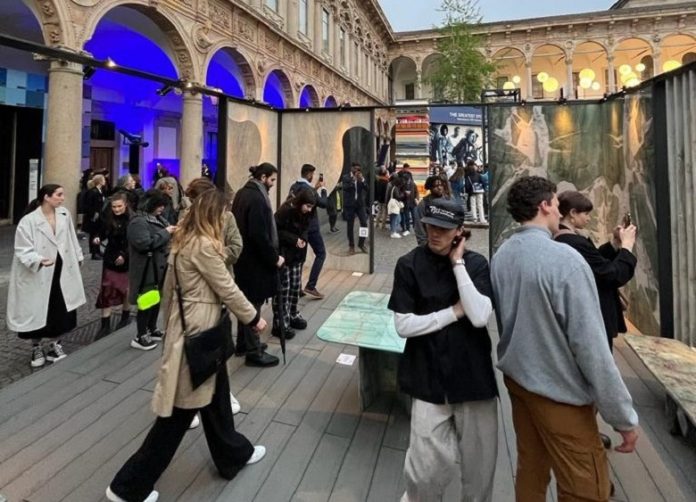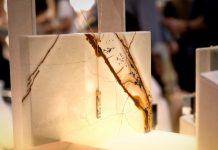The garden of the Università degli Studi di Milano enjoyed a special attraction during the Interni Design Re-Evolution exhibition as part of the Milan Design Week – FuoriSalone: a design intervention made entirely with Brazilian natural stone. Created by the architect and designer Vivian Coser, the Stone Pavilion caught the attention of the show’s visitors by displaying natural materials in slabs and design pieces from April 17th to 26th.
The exhibition was organized by It’s Natural – Brazilian Natural Stone, a project to encourage exports of Brazilian ornamental stones, promoted by the Brazilian Center for Ornamental Stone Exporters (Centrorochas) and the Brazilian Trade and Investment Promotion Agency (ApexBrasil).
During the ten days of the event, visitors had the opportunity to immerse themselves in the space designed under the essence of biophilia, a concept that brings the environment to urban spaces, which promotes well-being, emotional comfort, and a sense of relaxation. Structured with quartzite, semi-precious stone stone and dolomitic marble, the intervention was composed of materials from six Brazilian companies: Cajugram, Dapaz, Decolores, Gramazini, Granistone, and Pedra do Frade.
“It was an excellent opportunity to promote the Brazilian ornamental stones”, pointed out the general manager of Centrorochas, Giovanni Francischetto. Holder of the greatest geological diversity in the world, Brazil has a large industrial park for the supply of blocks, finished and semi-finished products, works of art, design, architecture, among others.
“The sector has managed to position itself in an attractive way and exalt its sustainable side,” Francischetto concluded. More than 95% of all water used in the production process is totally reused; moreover, the production residues are used or destined to licensed deposits. The stones also have a lower CO2 emission rate in production, compared to other coating options used in architectural projects.
Get to know the exhibited Brazilian stones at the event:
Amazonite (Supplied by Granistone)
An exotic semi-precious stone, made of quartz crystal, slat and a rare cyan colored pegmatite. It has great hardness and high resistance to acids and cleaning products. Because it has quartz in its composition, it can be backlit because it is translucent.
It can also be used in external areas, gourmet spaces, tables, bathrooms, pools, and furniture.
Apollo Light (Supplied by Cajugram)
The name Apollo was inspired by the sculptures of the Greek god of beauty, which seemed perfect for this quartzite. The material has light tones and soft veins that contrast with the quartz crystals, easily harmonizing with classic or modern settings. It is a versatile stone that can be integrated into more traditional and more daring designs in more exotic projects. Its composition is 95% quartz crystals, which makes it a very dense material, with a very homogeneous aspect, besides being hard, abrasion resistant, and with high resistance to compression and bending. The beauty of Apollo is mainly enhanced in its polished and satin finishes, and can be applied indoors or in outdoor projects, for floors, walls, and countertops.
Da Vinci (Supplied by Decolores)
Da Vinci quartzite is a lush stone composed of mineral relics such as quartz and fuchsite, which give it a translucent appearance and green color. It features intriguing structures such as stratifications, smooth lines that depict how the quartz sands moved in the environment where Da Vinci was formed 3 million years ago. It can be used in a variety of areas, including swimming pools.
Natura (Supplied by Pedra do Frade)
Natura quartzite comes from a region called Serra da Carnaíba, where there is the largest concentration of emeralds in Brazil, which explains the emerald green color. It is composed of green quartzite, white quartz crystals, intertwined with fuchsite and emerald slag.
Lunar (Provided by Pedra do Frade)
Lunar is a dolomitic marble from southern Bahia, Brazil. This material has a white background with grayish veins, bringing elegance and versatility. Since it is a dolomite marble, it has above average resistance and can be used in many different projects, including kitchens.
Polaris (Supplied by Gramazini)
A peculiar quartzite with an intense green and white color. This one stands out in the market, intriguing with its beauty and durability. Polaris is the brightest star in the constellation Ursa Minor and is located approximately at the north celestial pole. This is why it is called Polaris. With its color variations from green to white and gold, a new “star” was discovered, Polaris.
Speranza (Supplied by Granistone)
A unique quartzite with a dark green background and neon green moving veins, it has a high degree of hardness and resistance to acids and cleaning products. It can be used in indoor and outdoor areas.
Vanilla Sky (Supplied by Dapaz)
Vanilla Sky is a golden, tan, and white quartzite from Brazil. Its timeless design can be adapted to almost any kind of project, from traditional to modern. This metamorphic stone is extracted in the mountains of Ceará, and its origins can be dated back hundreds of millions of years. Mother Nature imprints on this masterpiece soft movements that resemble brushwork with subtle movements that surprise without impressing the eye.




































